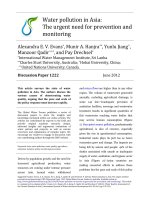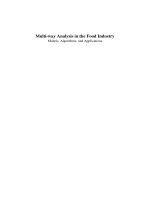PESTICIDES IN THE MODERN WORLD – PESTICIDES USE AND MANAGEMENT ppt
Bạn đang xem bản rút gọn của tài liệu. Xem và tải ngay bản đầy đủ của tài liệu tại đây (29.74 MB, 532 trang )
PESTICIDES IN THE
MODERN WORLD –
PESTICIDES USE AND
MANAGEMENT
Edited by Margarita Stoytcheva
Pesticides in the Modern World – Pesticides Use and Management
Edited by Margarita Stoytcheva
Published by InTech
Janeza Trdine 9, 51000 Rijeka, Croatia
Copyright © 2011 InTech
All chapters are Open Access distributed under the Creative Commons Attribution 3.0
license, which permits to copy, distribute, transmit, and adapt the work in any medium,
so long as the original work is properly cited. After this work has been published by
InTech, authors have the right to republish it, in whole or part, in any publication of
which they are the author, and to make other personal use of the work. Any republication,
referencing or personal use of the work must explicitly identify the original source.
As for readers, this license allows users to download, copy and build upon published
chapters even for commercial purposes, as long as the author and publisher are properly
credited, which ensures maximum dissemination and a wider impact of our publications.
Notice
Statements and opinions expressed in the chapters are these of the individual contributors
and not necessarily those of the editors or publisher. No responsibility is accepted for the
accuracy of information contained in the published chapters. The publisher assumes no
responsibility for any damage or injury to persons or property arising out of the use of any
materials, instructions, methods or ideas contained in the book.
Publishing Process Manager Sandra Bakic
Technical Editor Teodora Smiljanic
Cover Designer Jan Hyrat
Image Copyright Dudarev Mikhail, 2010. Used under license from Shutterstock.com
First published October, 2011
Printed in Croatia
A free online edition of this book is available at www.intechopen.com
Additional hard copies can be obtained from
Pesticides in the Modern World – Pesticides Use and Management,
Edited by Margarita Stoytcheva
p. cm.
978-953-307-459-7
free online editions of InTech
Books and Journals can be found at
www.intechopen.com
Contents
Preface IX
Part 1 Pesticides: Current Use 1
Chapter 1 Trends in the Exposures to Pesticides in Central Europe 3
Daniela Pelclova, Tomas Navratil,
Karolina Mrazova, Hana Rakovcova and Zdenka Fenclova
Chapter 2 Pesticide Utilisation, Regulation and Future
Prospects in Small Scale Horticultural Crop
Production Systems in a Developing Country 19
J. Karungi, S. Kyamanywa, E. Adipala and M. Erbaugh
Chapter 3 Pesticides in Burkina Faso:
Overview of the Situation in a Sahelian African Country 35
Moustapha Ouédraogo, Adama M. Toé,
Théodore Z. Ouédraogo and Pierre I. Guissou
Chapter 4 Pesticide Use in South Africa:
One of the Largest Importers of Pesticides in Africa 49
L.P. Quinn, B,J. de Vos, M. Fernandes-Whaley, C. Roos, H.
Bouwman, H. Kylin, R. Pieters and J. van den Berg
Chapter 5 Use of Pesticides for Vegetable Crops in Mexico 97
Ma. A. Pérez-Olvera, H. Navarro-Garza and E. Miranda-Cruz
Chapter 6 A Review on the Mode of Action and Current Use of
Petroleum Distilled Spray Oils 119
Micaela Buteler and Teodoro Stadler
Chapter 7 Design and Experiments on Droplet Charging
Device for High-Range Electrostatic Sprayer 137
Yu Ru, Hongping Zhou and Jiaqiang Zheng
Chapter 8 Reducing Spray Drift 149
Ilker H.Celen and Eray Onler
VI Contents
Part 2 Latest Advances in Biopesticides 167
Chapter 9 Natural Pesticides and Future Perspectives 169
Ivana Cavoski, Pierluigi Caboni and Teodoro Miano
Chapter 10 Neem Seed Oil: Encapsulation and Controlled Release -
Search for a Greener Alternative for Pest Control 191
Nirmala Devi and Tarun K. Maji
Chapter 11 Development of Neem Capsule via Biopolymer and Natural
Rubber for Its Controlled Release 233
Sa-Ad Riyajan
Chapter 12 Use of Botanical Pesticides in Modern Plant Protection 259
Kari Tiilikkala, Isa Lindqvist, Marleena Hagner,
Heikki Setälä and Dionyssios Perdikis
Chapter 13 Bacillus-Based Biological Control of Plant Diseases 273
Hélène Cawoy, Wagner Bettiol, Patrick Fickers and Marc Ongena
Chapter 14 The Effect of Some Botanical Pesticides Against
Citrus Leafminer (CLM) and Two Spotted Mite (TSM) 303
Behnam Amiri-Besheli
Part 3 Pesticides Management and Sustainable Development 325
Chapter 15 Ecological Effects of Pesticides 327
Deepa T.V., G. Lakshmi, Lakshmi P.S. and Sreekanth S.K.
Chapter 16 Changing to Minimal Reliance on Pesticides 337
Paul A. Horne and Jessica Page
Chapter 17 Increasing IPM Knowledge Through FFS in Benin 347
Trine Lund and Hafizur Rahman
Chapter 18 The Millardetian Conjunction in the Modern World 371
Marie-Pierre Rivière,
Michel Ponchet
and Eric Galiana
Chapter 19 Comparative Study of the Mobility of Malathion, Attamix
and Thiodan as Obsolete Pesticides in Colombian Soil 393
Rosalina González Forero
Chapter 20 Biodegradation of Pesticides 407
André Luiz Meleiro Porto, Gliseida Zelayarán Melgar,
Mariana Consiglio Kasemodel and Marcia Nitschke
Chapter 21 Pesticide-Soil Interaction 439
Rita Földényi, Imre Czinkota and László Tolner
Contents VII
Chapter 22 Application of Fenton
Processes for Degradation of Aniline 463
Chavalit Ratanatamskul, Nalinrut Masomboon and Ming-Chun Lu
Chapter 23 Bioremediation of Hexachlorocyclohexane
Contaminated Soil: Field Trials 475
H.K. Manonmani
Chapter 24 Setting Up of Risk Based Remediation
Goal for Remediation of Persistent Organic
Pesticides (Pesticide-POPs) Contaminated Sites 505
Tapan Chakrabarti
Preface
Volume 4 of the book series “Pesticides in the Modern World” contains 24 chapters
organized in three sections. It brings together issues on pesticides and biopesticides
use with the related subjects of pesticides management and sustainable development.
The first book section (Chapters 1-8) provides an overview on the current use of
pesticides, reporting data collected from all over the world. Chapter 1 is dedicated to
the trends in the pesticides use, frequency of exposure, and health effects in Central
Europe. Topics on pesticide utilisation, regulation and future prospects in small scale
horticultural crop production systems in Uganda are discussed in Chapter 2. The
objective of Chapter 3 is to provide an updated study on the patterns and impacts of
pesticides use in Sahelian countries, and especially in Burkina Faso. Chapter 4
furnishes an exhaustive information on the application of pesticides registered in
South Africa to control pests and disease vectors, on the regulatory status, on the
levels of contamination, and on the pesticides management options. Chapter 5
supplies an analysis on the use of pesticides in the horticulture in Mexico, taking into
account the existing regulations and the emerging during the last years problems such
as environmental deterioration, usage of pesticides restricted and prohibited in
Mexico, and a lack of training in the proper management of conventional and
alternative products.
In Chapter 6 are summarized the recent studies on the use and the mode of action of
the petroleum derived spray oils, found to be effective against orchard pests.
Pesticides application systems and techniques, aimed to produce uniform and fine
droplets with better droplet adhesion and distribution, higher depositing efficiency,
lower environmental contamination, and lower pesticide application rate are reported
in Chapters 7 and 8.
The second book section (Chapters 9-14) is devoted to the advances in the evolving
field of the biopesticides. Chapter 9 provides an actual information on the regulation
of the plant protection products from natural origin in the European Union, on the
associated organic farming practices, on the mode of action and the impacts of the
widespread botanical pesticides rotenone, azadirachtin and pyrethrins, and on the
current and future perspectives of the natural pesticides. Chapters 10 and 11 address
X Preface
the application of neem (azadirachtin)-based pesticides, considered as a promising
alternative to the synthetic pesticides, and on the techniques for the development of
controlled-release systems. Chapter 12 comments on the use of wood pyrolysis liquids
as plant protection products, and reveals the barriers in the commercialization of the
biological control agents.
Chapters 13 and 14 are axed on the utilization of bacillus-
based products as biopesticides, on the mechanisms involved in the biocontrol of the
plant diseases, and on the toxicity of the pesticides formulations.
The third book section (Chapters 15-24) covers various aspects of pesticides
management practices in concert with pesticides degradation and contaminated sites
remediation technologies, supporting the environmental sustainability. Chapters 15-19
call the attention on the ecological effects of the pesticides, provide information on
pesticides management science and techniques, and suggest strategies for reducing the
pesticides reliance and to develop integrated pest management knowledge. Chapters
20-24 fill the existing gap in data on pesticides degradation and biodegradation
processes, and environment remediation.
The present book is an important reference work for anyone involved in pesticides
issues, such as pesticides use and management. It was made possible due to the
knowledge and the expertise of the contributing authors. They are thankfully
acknowledged.
Margarita Stoytcheva
Mexicali, Baja California
Mexico
Part 1
Pesticides: Current Use
1
Trends in the Exposures to Pesticides
in Central Europe
Pelclova Daniela, Navratil Tomas, Mrazova Karolina,
Rakovcova Hana and Fenclova Zdenka
Toxicological Information Centre, Department of Occupational Medicine, First Faculty of
Medicine, Charles University in Prague, and General University Hospital, Prague,
Czech Republic
1. Introduction
The occupational exposures of the humans to pesticides may occur in the gardens, fields, and
forests during their dissemination, but also in the course of the preparatory activities, repair of
application equipment, and their re-entry, where most symptomatic exposures happened
(Meulenbelt & de Vries, 1997). Agricultural workers in several countries in Africa, Asia and
South America are at greater risk of pesticide poisoning than non-agricultural workers and
there appears a need for heightened efforts to better protect farm workers from pesticide
exposure (Litchfield, 2005, Dasgupta et al., 2006, Calvert et al., 2008, Mancini et al., 2009).
Pesticides also became a part of our households and are used for both outdoor and indoor
domestic application. As they are considered to be toxic by the general population, they are
frequently ingested with the intent to commit a suicide. Globally, agricultural pesticides
account for at least 250,000 suicide deaths each year, making pesticides the single most
common means of suicide worldwide (Gunnell et al., 2007, Nguyen et al., 2010, Lin et al.
2010, Roberts et al., 2010).
Additionally, children are frequently exposed to any type of pesticide, mostly by ingestion.
The exposure of children to pesticides may lead to a different outcome depending on the
type of pesticide, geographic location, healthcare system and other variables (Hruskovic et
al., 1984, Sudakin & Power, 2009), in South Africa it represents an increasingly important
problem and may lead to death (Balme et al., 2010).
Not surprisingly, both home pets and farm animals may come in touch with the pesticides,
either accidentally or due to aggressive behavior of some humans, trying to poison them
deliberately.
An amount of information has been written on the application of pesticides, their
degradation and analyses (Fischer et al., 2011). However, relatively little has been published
about the trends in the pesticides use, frequency of exposures and their changing impact on
the health in Central Europe.
Therefore, the aim of this chapter is to describe the situation based on the inquiries to the
Toxicological Information Centre (TIC) in Prague, which serves to the total Czech
population of approximately 10 million inhabitants. Since our last detailed evaluation of the
calls 20 years ago (Pelclova et al., 1991) the situation has substantially changed.
Pesticides in the Modern World – Pesticides Use and Management
4
2. Methods
Data from the TIC database from the period 1991 to 2010 have been retrospectively
evaluated. In all years, the information on the type of pesticide, dose, time, and way of
exposure; age and gender of the patient, reason of ingestion, symptoms, and treatment
recommended was available. As the electronic recording system started in 1997, the
registration of the calls by the physicians – toxicologists in the first period of this study, i.e.
in the years 1991-1996, was available only in the hard copy. Based on the electronic
recording system in the years 1997-2010, the evaluation of the clinical severity, prognosis,
and detailed recommendation for the case management were also available. All
intoxications were classified in accordance with the Poisoning Severity Score (Persson et al.
1998).
Additionally, the number of calls due to occupational exposures was compared with the
electronic Registry of Occupational Diseases (Urban et al., 2000), which collects all of
occupational diseases that were acknowledged and compensated in the Czech Republic. The
Registry records the information about the patient, exposure, job, diagnosis, noxious factors;
on the other hand, it does not include the acute injuries. Occupational diseases are classified
according to the chapters and intoxications with pesticides are recorded separately from
skin disorders caused by pesticides.
3. Results
3.1 Total calls due to pesticides
The number of total calls to the TIC continuously increases, as can be seen in Figure 1. In the
year 2010 it reached almost 12 thousand per year. Inquiries due to pesticides in the years
1991-2010 amounted total 8530 and accounted for 5.52% of total calls. As shown in Figure 1,
the proportion of the calls concerning pesticides slowly decreased from 7.81% in 1991 to
3.75% in 2010.
3.2 Seasonal variation
The calls to the TIC due to pesticides do not have a symmetric distribution throughout the
year and they display a seasonal variation, as can be seen in Figure 2. About 79.7% of all
exposures occurred in the vegetation period from April to October, during which the
occupational and home utilization of pesticides prevailed. Only 20.3% of inquiries were
asked in the other months. In the non-vegetation period the proportion of exposures from
other reasons, such as suicidal attempts and accidental ingestions of pesticides was more
pronounced.
3.3 The population concerned
Among the inquiries concerning pesticides, 44.7% (from 38.0 to 59.4%) concerned adults,
43.1% (36.9-52.1%) children, and 12.0% (2.9-22.3%) animals. The proportion of adults,
children, and animals during the years 1997-2010 did not exhibit a certain trend, as can be
seen in Figure 3.
As to the gender of the subjects in human exposures, 56.6% of calls involved men; 41.8%
women; and the gender was unknown in 1.6%.
Trends in the Exposures to Pesticides in Central Europe
5
Fig. 1. Total number of calls to the TIC of the Czech Republic and the number of calls due to
pesticides in the years 1991-2010
Fig. 2. Average number of calls to the TIC concerning pesticides throughout the months of
the year.
Pesticides in the Modern World – Pesticides Use and Management
6
Fig. 3. The population in the calls to the TIC concerning pesticides in the years 1997-2010
3.4 The reason of exposure
Pesticide exposures occurred predominantly accidentally (including house work, wrong use
and children exposures), which was the case in 90.5% of the calls due to pesticides in the years
1997-2010. In total, only 5.9% exposures were suicidal, 2.7% occupational and 0.7% due to
aggressive behavior. The percentage of other or unknown reasons amounted to about 2.9%.
Fig. 4. The reason of exposure in the calls, concerning pesticides to the TIC in the years 1997-
2010
A detailed analysis of the causes of exposure was possible in the past 6 years and can be
seen in Figure 5. Again, most common was the unintentional exposure; the second most
Trends in the Exposures to Pesticides in Central Europe
7
frequent reason of exposure was the house work with pesticides. As can be seen, the suicidal
exposure slightly decreased. Another new item, wrong use, appeared in the statistic.
Fig. 5. Detailed reasons of exposure in the calls to the TIC in the years 2005-2010
The percentage of inquiries due to occupational exposures dropped in the last 6 years from
2.7% to 1.6%.
Accordingly, the data of the Registry of Occupational Diseases shows a low number of
occupational diseases.
The poisonings with pesticides during past 20 years involved only 2 workers,
occupationally exposed to synthetic pyrethrins, as can be seen in Figure 6.
Fig. 6. Occupational diseases due to pesticides according to the Registry of Occupational
Diseases in the Czech Republic in the years 1991-2010.
Pesticides in the Modern World – Pesticides Use and Management
8
Occupational skin disorders were more frequent and involved 6 cases of contact allergic
dermatitis. The diseases occurred due to the exposure to propoxur, cypermethrin,
mancozeb. Other 5 subjects developed the contact irritant dermatitis (due to permethrin,
triadimefon, metiram, sulfur, copper oxychloride, methyl and benzisothiazolinone).
As can be seen in Figure 6, last occupational disorders were acknowledged in 2006.
3.5 The route of exposure
Ingestion was the most frequent scenario of exposure and accounted for 85.1%, inhalation
for 12.4% and skin contamination for 2.5% of the calls due to pesticides.
Obviously, ingestion was the most common way of exposure in children and in adults
committing suicide; on the other hand, the inhalation played a role in exposure almost
exclusively in adults during their domestic or occupational work with pesticides in the
house, garden or field.
Fig. 7. The route of exposure to pesticides in the calls to the TIC in the years 1997-2010
3.6 The symptoms
The symptoms of intoxication in all inquiries due to all pesticides in the years 1997-2010
were absent in 69.7% of subjects, including the animals. About 23.6% of subjects had mild
symptoms, 4.2% medium, and 0.6% severe; the symptoms at the time of the call were
unknown in the rest of the cases. Consultation of a decease concerning a pesticide was the
reason of the phone call in 0.1% of cases only.
Trends in the Exposures to Pesticides in Central Europe
9
The severity of symptoms was not the same in the group of cholinergic pesticides, in the
group of rodenticides and other pesticides (fungicides, herbicides, moluscocides, etc.).
The differences in the frequency of symptoms due distinct groups of pesticides at the time of
the inquiry can be seen in Figure 8 (for organophosphates and carbamates), Figure 9 (for
rodenticides), and Figure 10 (for other pesticides).
No lethal case was recorded due to exposure to a rodenticide, inclusive the suicide attempts
during the past 14 years. In humans, symptoms of bleeding developed after a repeated
exposure, including skin exposure due to a contaminated bed in the hayloft. In other
subjects, the exposure to rodenticides has not been proven and was merely considered in
differential diagnosis. The symptoms occurred mostly in animals, especially dogs, where
repeated exposures could not be excluded.
Fig. 8. Symptoms due to cholinergics (organophosphates and carbamates) during the call to
the TIC in the years 1997-2010
Pesticides in the Modern World – Pesticides Use and Management
10
Fig. 9. Symptoms due to rodenticides during the call to the TIC in the years 1997-2010
Fig. 10. Symptoms due to other pesticides during the call to the TIC in the years 1997-2010
Symptomatic exposures to other pesticides concerned most frequently the dogs, exposed to
moluscocides.
Trends in the Exposures to Pesticides in Central Europe
11
3.7 The dose of the pesticide
The level of the pesticide exposure, evaluated by the physician at the time of the call, is
shown in Figure 11; the most frequent evaluation was “Low”.
The difficulty to make an exact estimate of the dose is seen in the high percentage of the
“Unknown” classification, which includes especially oral exposures of the children and
animals on one hand, and inhalational and skin exposures in all subjects at the other
hand.
3.8 Prognosis of the exposure
Prognosis of the pesticide exposure, evaluated individually in every patient at the time of
the call, is presented in Figure 11. The decision was based on several parameters, able to
influence further development of the exposure/intoxication. To the most important
parameters belonged especially the dose of the pesticide, time interval since the exposure,
the symptoms of the patient, and the availability of the antidote or other efficient
treatment.
It can be seen that the counts are relatively stable and prognosis is relatively favorable.
Fig. 11. Dose of the pesticide, evaluated at the time of the call to the TIC in the years 2005-
2010
Pesticides in the Modern World – Pesticides Use and Management
12
Fig. 12. Prognosis of the exposure, evaluated at the time of the call to the TIC in the years
2005-2010
3.9 Trends in the types of pesticides
The decrease in the number of calls since the 90ies can be seen especially in the group of
insecticides. In spite of the increasing number of total calls, the number of inquiries due to
pesticides remained mostly stable during the years, even with 10year´s intervals, as can be
seen in Table 1.
Year 1988 1989 1998 1999 2008 2009
Insecticides 180 128 180 189 134 132
Rodenticides 110 77 140 105 114 69
Herbicides 41 36 50 68 49 52
Fungicides 24 20 44 51 25 22
Other pesticides 20 14 17 27 50 49
TOTAL 375 275 431 440 372 324
Table 1. The types of pesticides in the calls to the TIC in selected years during two decades
In the electronic recording of the structured format of the calls in the past decade, the mean
percentage of the calls due to rodenticides amounted 26.6%, cholinergic insecticides 13.0%,
other insecticides, mostly pyrethrin-based 18.4%.
Herbicides reached 16.3%, among them, glyphosate took the first place with a slowly decrease
from 12.2%, 10.2%, 10.8%, 10.8% to 7.2% in the years 2006, 2007, 2008, 2009 and 2010,
respectively. The proportion of moluscocides and fungicides was 6.0% and 8.6%, respectively.
Trends in the Exposures to Pesticides in Central Europe
13
When the trends in the participation of different groups of pesticides were evaluated, only
fungicides displayed a minor decrease of the calls since 2000, as can be seen in Figure 13.
Fig. 13. Trends in the percentage of calls due to different groups of pesticides in the calls in
the years 2000-2010
3.10 Exposures in animals
Veterinary calls in the 20 year´s period represented 0.6% of the total calls to the TIC. In the last
decade the percentage mildly increased and lies in the range of 0.8-1.9%. However, calls
concerning animals reached 12.0% of the calls due pesticides, i.e. 2-3 times more than the
humans. Exposures with a higher severity were registered for pyrethrins, wrongly used as
insecticides in cats. On the other hand, carbofuran was given to the dogs or birds supposedly
with the intent to damage or kill them by the neighbors. Moluscocide metaldehyde in pellets,
appearing attractive to the dogs, carbofuran, and glyphosate belonged to the most frequent
causes of symptomatic exposures.
3.11 Selected case reports of exposures
3.11.1 Unintentional ingestions
2 years-old male drank organophosphate metathion from a bottle in the garden. His father
immediately induced vomiting and brought him to the hospital, where the boy vomited
again. Gastric lavage was performed and charcoal given. The patient received atropine;
however, the symptoms appeared 3.5 hours later – fasciculations, diarrhea, and bradycardia.
The condition slowly improved after repeated atropine injections and resolved within 20
hours without sequels (April 1991).
46 years-old female took by mistake 7 ml of liquid organophosphate diazinon instead of
antitussic drops. Within few minutes she began to vomit spontaneously, experienced
cholinergic symptoms, weakness and muscle fasciculations. She was treated with atropine
in infusion. Cholinesterase on admission was 6.0 µkat/l, further decreased to 0.5 µkat/l and
on discharge within 8 days it increased to 13.3 µkat/l. Normal level is 87-190 μkat/l.
(September 1999).









